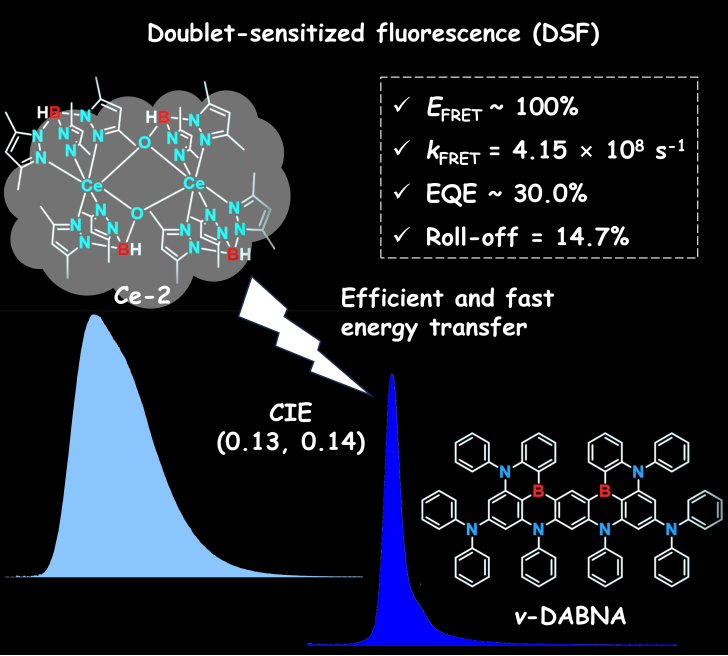Ultrahigh-definition displays are placing increasingly higher demands on the performance of organic light-emitting diodes (OLEDs), necessitating high efficiency, stability, and narrowband emission. In recent years, multi-resonance thermally activated delayed fluorescence (MR-TADF) materials have rapidly developed due to their efficient narrow-band emission, showing great potential for achieving high-efficiency, high-color-purity OLEDs.
However, MR-TADF molecules typically exhibit long exciton lifetimes, posing significant challenges to device stability—particularly in blue OLEDs—since the accumulation and collision of excitons in the blue-emitting layer can generate high-energy excitons, leading to chemical-bond dissociation. Fast and efficient exciton utilization is a crucial solution and highly desirable for achieving high-performance blue OLEDs.
In a study published in Advanced Materials, the research group led by Prof. LU Canzhong and Prof. CHEN Xulin from the Fujian Institute of Research on the Structure of Matter, Chinese Academy of Sciences, proposed and implemented a novel sensitization strategy, termed doublet-sensitized fluorescence (DSF), to achieve high-performance deep-blue electroluminescence.
In the DSF-OLEDs, a doublet-emitting cerium(III) complex, the researchers employed Ce-2 as the sensitizer for the MR-TADF emitter v-DABNA. Since the generation of doublet excitons is not restricted by spin statistics , and doublet radiative transitions and energy transfer are free from spin-forbidden constraints, this strategy enables the efficient and rapid utilization of excitons.
Besides, the researchers utilized a doublet-emitting rare-earth complex, Ce-2, as the sensitizer and the MR-TADF material v-DABNA as the terminal emitter to fabricate DSF-OLEDs. Experimental results demonstrated that, in the emitting layer of the DSF-OLEDs, the ground state of Ce-2 captures a hole to form a Ce(IV) species, which then readily combined with an injected electron to form a doublet excited state [Ce(III)*].
Subsequently, the energy of the doublet excitons transfers to the first singlet excited state of the terminal emitter via efficient Förster resonance energy transfer (FRET), which occurs without the need for spin-flip. Unlike the situation where a portion of excitons are initially generated on the co-host upon photoexcitation, in the DSF-OLED, excitons are predominantly generated on Ce-2. This significantly reduces the ratios of triplet excitons and delayed fluorescence by avoiding triplet-triplet Dexter energy transfer (DET) from the cohost to 𝜈-DABNA.
This study highlights the significant potential of the DSF strategy in achieving efficient, stable, and high-color-purity blue OLEDs, making it highly promising for applications in ultra-high-definition OLED displays.

Performance Overview (Image by Prof. LU’s group)
Contact:
Prof. LU Canzhong
Fujian Institute of Research on the Structure of Matter
Chinese Academy of Sciences
Email: czlu@fjirsm.ac.cn